
Concept explainers
(a)
Interpretation:
The structure is to be drawn, and the correct IUPAC name for the given trivial name is to be provided.
Concept introduction:
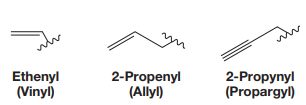
Trivial names such as iso and neo, sec, tert are used to indicate the alkyl groups and their structure as shown below:
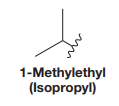
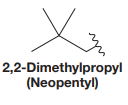
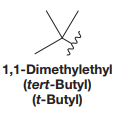
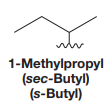
The root names of ketones are derived from those of the parent
Answer to Problem E.23P
The correct IUPAC name for the given trivial name

Explanation of Solution
The name for the given molecule is

The prefix di represents that there are two vinyl groups attached to the carbonyl carbon atom in ketone. Thus, the structure for

While writing the IUPAC name for ketones, the longest continuous carbon chain containing the ketone functional group is to be determined, and it is numbered such that the carbonyl carbon receives the lowest possible numbering. Using this rule, the numbering for the above structure is

The longest continuous carbon chain has five carbon atoms, and the carbonyl carbon is at number 3. Thus, the root name for this will be
The structure of the molecule is drawn and the correct IUPAC name is written for the given trivial name.
(b)
Interpretation:
The structure is to be drawn, and the correct IUPAC name for the given trivial name is to be provided.
Concept introduction:
Ketones consist of two alkyl or aryl groups attached to a carbonyl group, and their trivial names consist of identifying the alkyl or aryl groups and listing them both before the word ketone. Alkyl groups can be alkenes, alkynes, or benzene derivatives. Some of the most common names for alkenes and alkynes are vinyl, allyl, or propargyl. Their structures are as follows:

Trivial names such as iso and neo, sec, tert are used to indicate the alkyl groups and their structure as shown below:




The root names of ketones are derived from those of the parent alkanes, defined by the longest continuous chain of carbon atoms that contains the functional group. For a ketone, drop the -e from the alkane name and add the ending one. To indicate the position of a substituent on a ketone, number the chain in the manner that gives the carbonyl carbon atom the lowest possible locator number. In cyclic ketones, it is understood that the carbonyl carbon atom is C1.
Answer to Problem E.23P
The correct IUPAC name for the given trivial name
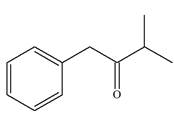
Explanation of Solution
The name for the given molecule is

While writing the IUPAC name for ketones, the longest continuous carbon chain containing the ketone functional group is to be determined, and it is numbered such that the carbonyl carbon receives the lowest possible numbering. Using this rule, the numbering for the above structure is
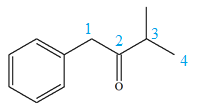
The longest continuous carbon chain has four carbon atoms, and the carbonyl carbon is at number 2. Thus, the root name for this will be
The structure of the molecule is drawn, and the correct IUPAC name is written for the given trivial name.
(c)
Interpretation:
The structure is to be drawn, and the correct IUPAC name for the given trivial name is to be provided.
Concept introduction:
Ketones consist of two alkyl or aryl groups attached to a carbonyl group, and their trivial names consist of identifying the alkyl or aryl groups and listing them both before the word ketone. Alkyl groups can be alkenes, alkynes, or benzene derivatives. Some of the most common names for alkenes and alkynes are vinyl, allyl, or propargyl. Their structures are as follows:

Trivial names such as iso and neo, sec, tert are used to indicate the alkyl groups and their structure as shown below:




The root names of ketones are derived from those of the parent alkanes, defined by the longest continuous chain of carbon atoms that contains the functional group. For a ketone, drop the -e from the alkane name and add the ending one. To indicate the position of a substituent on a ketone, number the chain in the manner that gives the carbonyl carbon atom the lowest possible locator number. In cyclic ketones, it is understood that the carbonyl carbon atom is C1.
Answer to Problem E.23P
The correct IUPAC name for the given trivial name
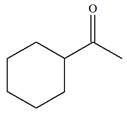
Explanation of Solution
The name for the given molecule is

While writing the IUPAC name for ketones, the longest continuous carbon chain containing the ketone functional group is to be determined, and it is numbered such that the carbonyl carbon receives the lowest possible numbering. Using this rule, the numbering for the above structure is
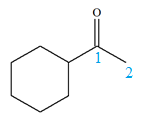
The longest continuous carbon chain has two carbon atoms, and the carbonyl carbon is at number 1. Thus, the root name for this will be
The structure of the molecule is drawn, and the correct IUPAC name is written for the given trivial name.
(d)
Interpretation:
The structure is to be drawn, and the correct IUPAC name for the given trivial name is to be provided.
Concept introduction:
Ketones consist of two alkyl or aryl groups attached to a carbonyl group, and their trivial names consist of identifying the alkyl or aryl groups and listing them both before the word ketone. Alkyl groups can be alkenes, alkynes, or benzene derivatives. Some of the most common names for alkenes and alkynes are vinyl, allyl, or propargyl. Their structures are as follows:

Trivial names such as iso and neo, sec, tert are used to indicate the alkyl groups and their structure as shown below:




The root names of ketones are derived from those of the parent alkanes, defined by the longest continuous chain of carbon atoms that contains the functional group. For a ketone, drop the -e from the alkane name and add the ending one. To indicate the position of a substituent on a ketone, number the chain in the manner that gives the carbonyl carbon atom the lowest possible locator number. In cyclic ketones, it is understood that the carbonyl carbon atom is C1.
Answer to Problem E.23P
The correct IUPAC name for the given trivial name
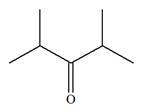
Explanation of Solution
The name for the given molecule is

There is no other substituent present; thus, the structure for the compound is

While writing the IUPAC name for ketones, the longest continuous carbon chain containing the ketone functional group is to be determined, and it is numbered such that the carbonyl carbon receives the lowest possible numbering. Using this rule, the numbering for the above structure is
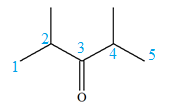
The longest continuous carbon chain has five carbon atoms, and the carbonyl carbon is at number 3. Thus, the root name for this will be
The structure of the molecule is drawn, and the correct IUPAC name is written for the given trivial name.
(e)
Interpretation:
The structure is to be drawn, and the correct IUPAC name for the given trivial name is to be provided.
Concept introduction:
Ketones consist of two alkyl or aryl groups attached to a carbonyl group, and their trivial names consist of identifying the alkyl or aryl groups and listing them both before the word ketone. Alkyl groups can be alkenes, alkynes, or benzene derivatives. Some of the most common names for alkenes and alkynes are vinyl, allyl, or propargyl. Their structures are as follows:

Trivial names such as iso and neo, sec, tert are used to indicate the alkyl groups and their structure as shown below:




The root names of ketones are derived from those of the parent alkanes, defined by the longest continuous chain of carbon atoms that contains the functional group. For a ketone, drop the -e from the alkane name and add the ending one. To indicate the position of a substituent on a ketone, number the chain in the manner that gives the carbonyl carbon atom the lowest possible locator number. In cyclic ketones, it is understood that the carbonyl carbon atom is C1.
Answer to Problem E.23P
The correct IUPAC name for the given trivial name
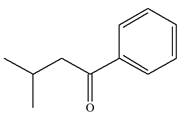
Explanation of Solution
The name for the given molecule is

There is no other substituent present; thus, the structure for the compound is
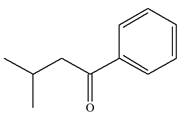
While writing the IUPAC name for ketones, the longest continuous carbon chain containing the ketone functional group is to be determined, and it is numbered such that the carbonyl carbon receives the lowest possible numbering. Using this rule, the numbering for the above structure is
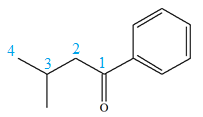
The longest continuous carbon chain has four carbon atoms, and the carbonyl carbon is at number 1. Thus, the root name for this will be
The structure of the molecule is drawn, and the correct IUPAC name is written for the given trivial name.
Want to see more full solutions like this?
Chapter E Solutions
Organic Chemistry: Principles And Mechanisms: Study Guide/solutions Manual (second)
- Predict the product of this organic reaction: IZ + HO i P+H₂O Specifically, in the drawing area below draw the skeletal ("line") structure of P. If there is no reasonable possibility for P, check the No answer box under the drawing area. No Answer Click and drag to start drawing a structure. ☐ :arrow_forwardPredict the products of this organic reaction: 0 O ----- A + KOH ? CH3-CH2-C-O-CH2-C-CH3 Specifically, in the drawing area below draw the condensed structure of the product, or products, of this reaction. (If there's more than one product, draw them in any arrangement you like, so long as they aren't touching.) If there aren't any products because this reaction won't happen, check the No reaction box under the drawing area. No reaction Click anywhere to draw the first atom of your structure. X ⑤ èarrow_forwardPredict the products of this organic reaction: O CH3 + H2O + HCI A A? CH3-CH2-C-N-CH3 Specifically, in the drawing area below draw the condensed structure of the product, or products, of this reaction. If there's more than one product, draw them in any arrangement you like, so long as they aren't touching. If there aren't any products because this reaction won't happen, check the No reaction box under the drawing area. No Reaction Click anywhere to draw the first atom of your structure.arrow_forward
- What is the missing reactant in this organic reaction? R+ HO-C-CH2-CH3 0= CH3 CH3 —CH, C−NH—CH CH3 + H₂O Specifically, in the drawing area below draw the condensed structure of R. If there is more than one reasonable answer, you can draw any one of them. If there is no reasonable answer, check the No answer box under the drawing area. Note for advanced students: you may assume no products other than those shown above are formed. No Answer Click anywhere to draw the first atom of your structure. €arrow_forward个 CHEM&131 9267 - $25 - Intro to Mail - Hutchison, Allison (Student x Aktiv Learnin https://app.aktiv.com Draw the product of the reaction shown below. Ignore inorganic byproducts. + Na2Cr2O7 Acetone, H2SO4 Type here to search Dryng OH W Prarrow_forwardPredict the products of this organic reaction: OH + NaOH A? Specifically, in the drawing area below draw the skeletal ("line") structure of the product, or products, of this reaction. (If there's more than one product, draw them in any arrangement you like, so long as they aren't touching.) If there aren't any products because this reaction won't happen, check the No reaction box under the drawing area. No reaction Click and drag to start drawing a structure. ✓ Sarrow_forward
- Predict the products of this organic reaction: CH3-C-O-CH2-CH2-C-CH3 + H₂O ? A Specifically, in the drawing area below draw the condensed structure of the product, or products, of this reaction. (If there's more than one product, draw them in any arrangement you like, so long as they aren't touching.) If there aren't any products because this reaction won't happen, check the No reaction box under the drawing area. No reaction Click anywhere to draw the first atom of your structure. :☐ darrow_forwardDE d. Draw an arrow pushing mechanism for the following IN O CI N fo 人 P Polle DELL prt sc home end ins F5 F6 F7 F8 F9 F10 F11 F12arrow_forwardPredict the products of this organic reaction: + H₂O H* ? A Specifically, in the drawing area below draw the skeletal ("line") structure of the product, or products, of this reaction. (If there's more than one product, draw them in any arrangement you like, so long as they aren't touching.) If there aren't any products because this reaction won't happen, check the No reaction box under the drawing area. No Reaction Click and drag to start drawing a structure.arrow_forward
- Predict the major organic products of the reaction below and draw them on right side of the arrow. If there will be no significant reaction, check the box below the drawing area instead. C Cl CH, OH There will be no significant reaction. + pyridine G Click and drag to start drawing a structure.arrow_forwardWhat is the missing reactant in this organic reaction? H R+ H2O Δ OH 0= CH3-CH-O-CH3 + CH3-C-OH Specifically, in the drawing area below draw the condensed structure of R. If there is more than one reasonable answer, you can draw any one of them. If there is no reasonable answer, check the No answer box under the drawing area. No Answer Click anywhere to draw the first atom of your structure. dyarrow_forwardYou are trying to determine whether the following organic reaction can be done in a single synthesis step. If so, add any missing reagents or conditions in the drawing area below. If it isn't possible to do this reaction in a single synthesis step, check the box below the drawing area instead. Note for advanced students: if you have a choice of reagents to add, you should choose the least reactive and most economical reagents possible. Cl It isn't possible to do this reaction in a single synthesis step. + T OHarrow_forward
 Chemistry for Today: General, Organic, and Bioche...ChemistryISBN:9781305960060Author:Spencer L. Seager, Michael R. Slabaugh, Maren S. HansenPublisher:Cengage Learning
Chemistry for Today: General, Organic, and Bioche...ChemistryISBN:9781305960060Author:Spencer L. Seager, Michael R. Slabaugh, Maren S. HansenPublisher:Cengage Learning Organic Chemistry: A Guided InquiryChemistryISBN:9780618974122Author:Andrei StraumanisPublisher:Cengage Learning
Organic Chemistry: A Guided InquiryChemistryISBN:9780618974122Author:Andrei StraumanisPublisher:Cengage Learning Organic And Biological ChemistryChemistryISBN:9781305081079Author:STOKER, H. Stephen (howard Stephen)Publisher:Cengage Learning,
Organic And Biological ChemistryChemistryISBN:9781305081079Author:STOKER, H. Stephen (howard Stephen)Publisher:Cengage Learning, General, Organic, and Biological ChemistryChemistryISBN:9781285853918Author:H. Stephen StokerPublisher:Cengage LearningChemistry: Matter and ChangeChemistryISBN:9780078746376Author:Dinah Zike, Laurel Dingrando, Nicholas Hainen, Cheryl WistromPublisher:Glencoe/McGraw-Hill School Pub Co
General, Organic, and Biological ChemistryChemistryISBN:9781285853918Author:H. Stephen StokerPublisher:Cengage LearningChemistry: Matter and ChangeChemistryISBN:9780078746376Author:Dinah Zike, Laurel Dingrando, Nicholas Hainen, Cheryl WistromPublisher:Glencoe/McGraw-Hill School Pub Co Chemistry: Principles and PracticeChemistryISBN:9780534420123Author:Daniel L. Reger, Scott R. Goode, David W. Ball, Edward MercerPublisher:Cengage Learning
Chemistry: Principles and PracticeChemistryISBN:9780534420123Author:Daniel L. Reger, Scott R. Goode, David W. Ball, Edward MercerPublisher:Cengage Learning





